Accounting & Finance Homework: Investment Analysis and Returns
VerifiedAdded on 2023/06/14
|12
|2470
|250
Homework Assignment
AI Summary
This assignment solution covers several key areas of accounting and finance, including investment analysis, tax implications, and portfolio returns. It begins by calculating the present value of a cash flow stream to determine the investment's worth, followed by computing loan payments and investment values with compound interest. The impact of a corporate tax rate reduction in Australia is analyzed, considering potential benefits like increased investment and job opportunities, as well as drawbacks such as reduced government revenue. The solution also assesses the monthly returns, standard deviation, and annual holding period returns for NAB, BHP, and AORD stocks. Finally, it uses the Capital Asset Pricing Model (CAPM) and Security Market Line (SML) to evaluate investment decisions, concluding with a recommendation to invest in BHP Billiton based on its higher average monthly return. Desklib provides a platform for students to access similar solved assignments and study resources.
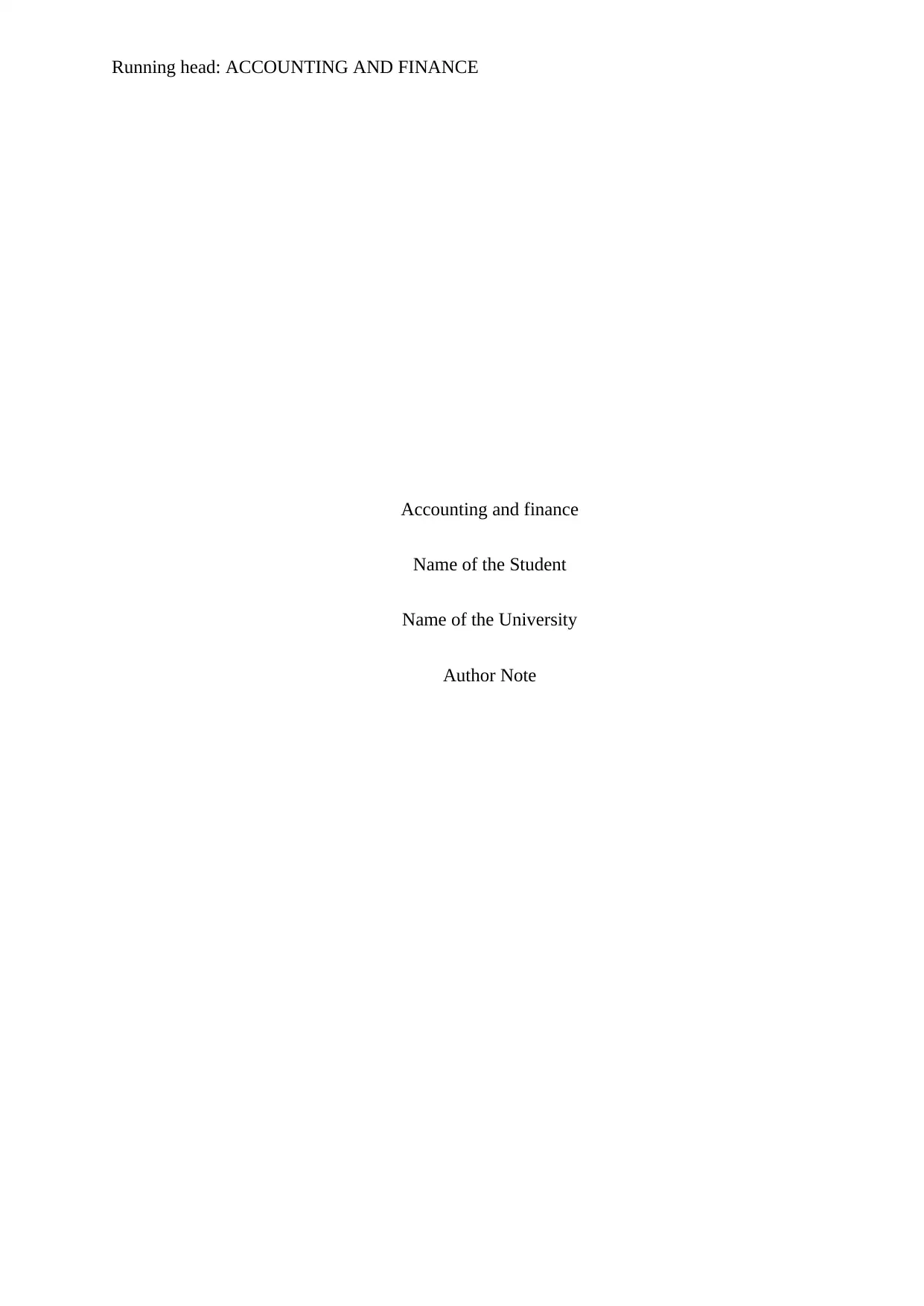
Running head: ACCOUNTING AND FINANCE
Accounting and finance
Name of the Student
Name of the University
Author Note
Accounting and finance
Name of the Student
Name of the University
Author Note
Paraphrase This Document
Need a fresh take? Get an instant paraphrase of this document with our AI Paraphraser
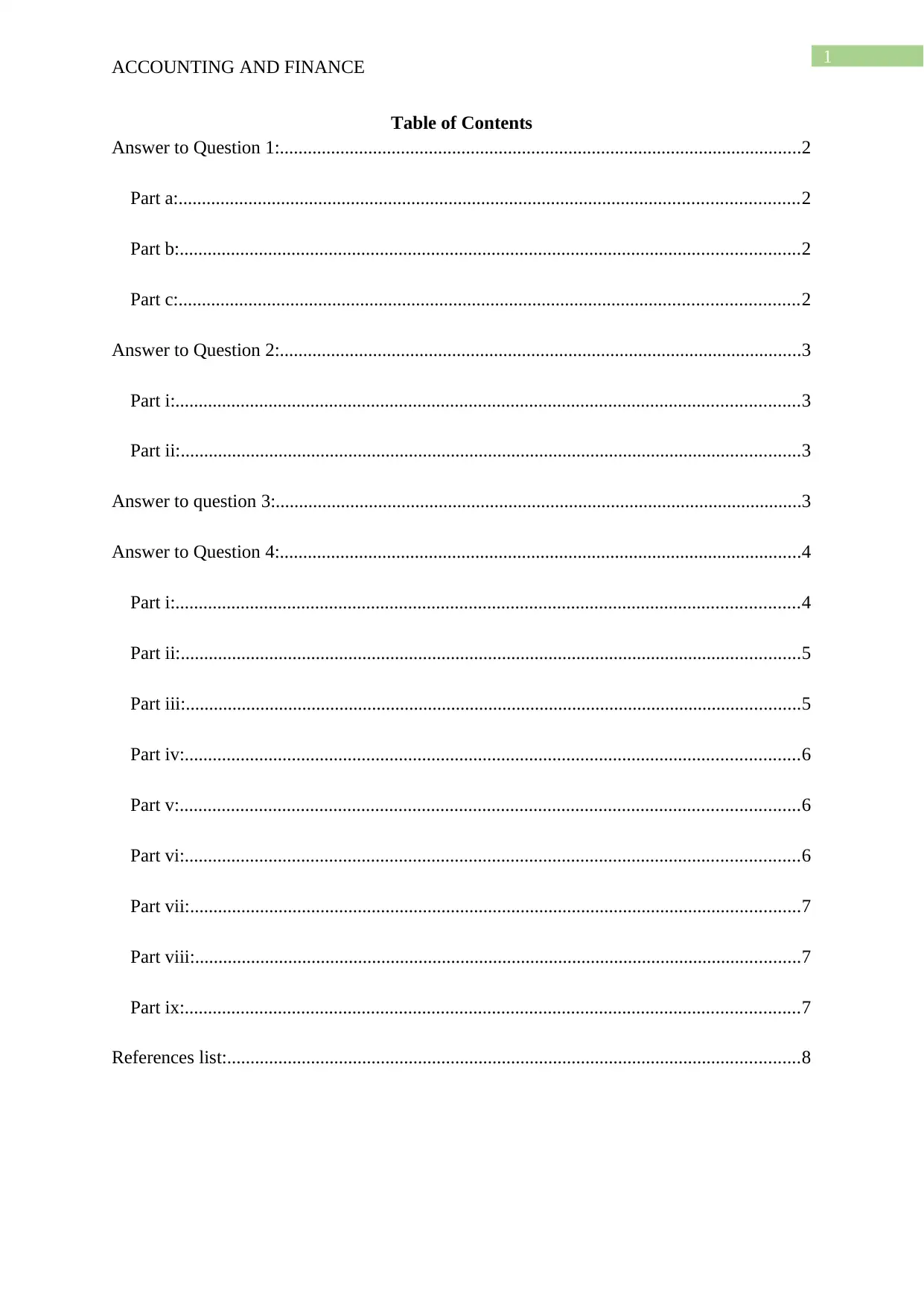
1
ACCOUNTING AND FINANCE
Table of Contents
Answer to Question 1:................................................................................................................2
Part a:.....................................................................................................................................2
Part b:.....................................................................................................................................2
Part c:.....................................................................................................................................2
Answer to Question 2:................................................................................................................3
Part i:......................................................................................................................................3
Part ii:.....................................................................................................................................3
Answer to question 3:.................................................................................................................3
Answer to Question 4:................................................................................................................4
Part i:......................................................................................................................................4
Part ii:.....................................................................................................................................5
Part iii:....................................................................................................................................5
Part iv:....................................................................................................................................6
Part v:.....................................................................................................................................6
Part vi:....................................................................................................................................6
Part vii:...................................................................................................................................7
Part viii:..................................................................................................................................7
Part ix:....................................................................................................................................7
References list:...........................................................................................................................8
ACCOUNTING AND FINANCE
Table of Contents
Answer to Question 1:................................................................................................................2
Part a:.....................................................................................................................................2
Part b:.....................................................................................................................................2
Part c:.....................................................................................................................................2
Answer to Question 2:................................................................................................................3
Part i:......................................................................................................................................3
Part ii:.....................................................................................................................................3
Answer to question 3:.................................................................................................................3
Answer to Question 4:................................................................................................................4
Part i:......................................................................................................................................4
Part ii:.....................................................................................................................................5
Part iii:....................................................................................................................................5
Part iv:....................................................................................................................................6
Part v:.....................................................................................................................................6
Part vi:....................................................................................................................................6
Part vii:...................................................................................................................................7
Part viii:..................................................................................................................................7
Part ix:....................................................................................................................................7
References list:...........................................................................................................................8
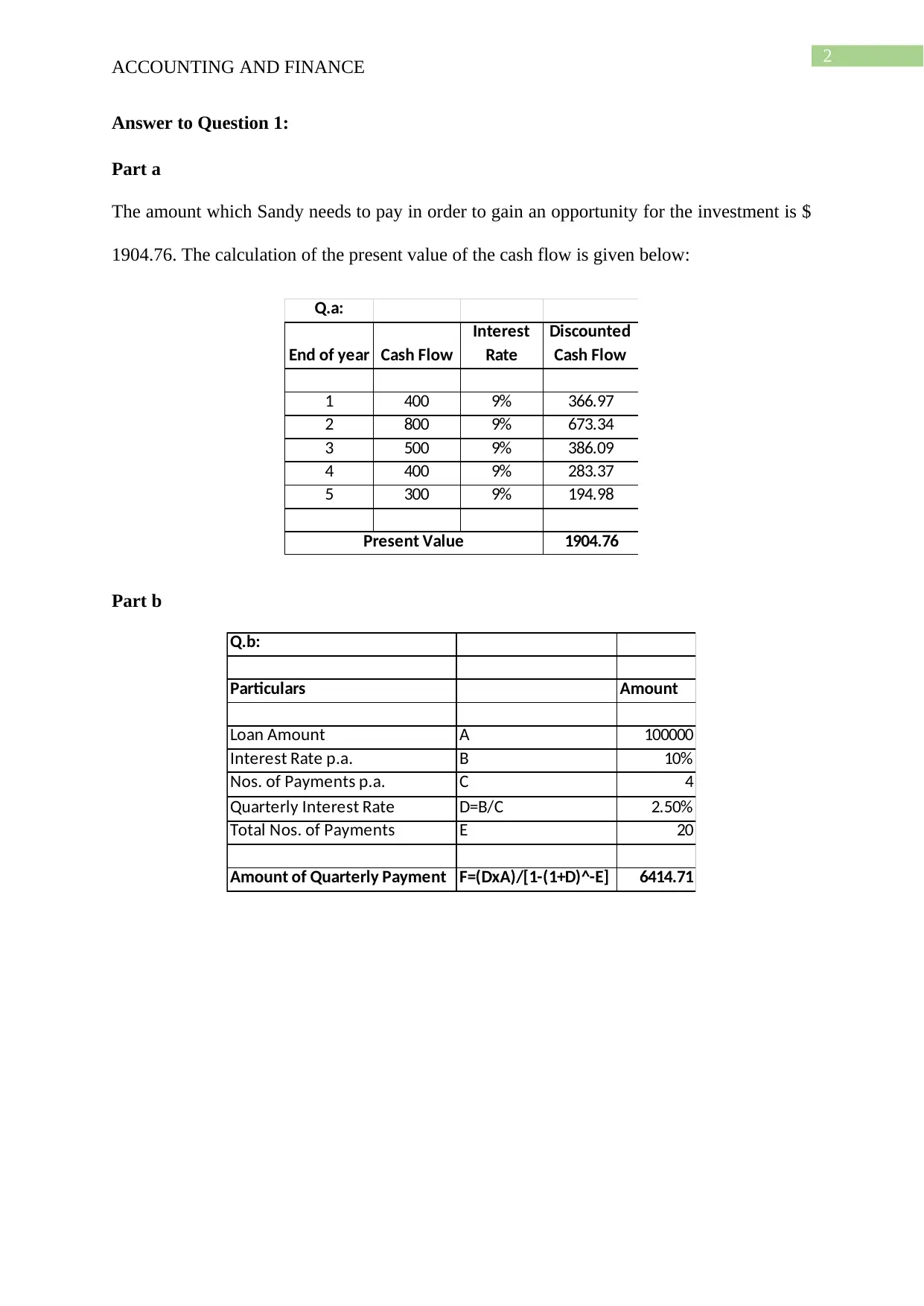
2
ACCOUNTING AND FINANCE
Answer to Question 1:
Part a
The amount which Sandy needs to pay in order to gain an opportunity for the investment is $
1904.76. The calculation of the present value of the cash flow is given below:
Q.a:
End of year Cash Flow
Interest
Rate
Discounted
Cash Flow
1 400 9% 366.97
2 800 9% 673.34
3 500 9% 386.09
4 400 9% 283.37
5 300 9% 194.98
1904.76Present Value
Part b
Q.b:
Particulars Amount
Loan Amount A 100000
Interest Rate p.a. B 10%
Nos. of Payments p.a. C 4
Quarterly Interest Rate D=B/C 2.50%
Total Nos. of Payments E 20
Amount of Quarterly Payment F=(DxA)/[1-(1+D)^-E] 6414.71
ACCOUNTING AND FINANCE
Answer to Question 1:
Part a
The amount which Sandy needs to pay in order to gain an opportunity for the investment is $
1904.76. The calculation of the present value of the cash flow is given below:
Q.a:
End of year Cash Flow
Interest
Rate
Discounted
Cash Flow
1 400 9% 366.97
2 800 9% 673.34
3 500 9% 386.09
4 400 9% 283.37
5 300 9% 194.98
1904.76Present Value
Part b
Q.b:
Particulars Amount
Loan Amount A 100000
Interest Rate p.a. B 10%
Nos. of Payments p.a. C 4
Quarterly Interest Rate D=B/C 2.50%
Total Nos. of Payments E 20
Amount of Quarterly Payment F=(DxA)/[1-(1+D)^-E] 6414.71
⊘ This is a preview!⊘
Do you want full access?
Subscribe today to unlock all pages.

Trusted by 1+ million students worldwide

3
ACCOUNTING AND FINANCE
Part c
Q.c:
Particulars Amount
Investment Value A $2,00,000
Interest Rate p.a. B 10%
Nos. of Compounding Periods
p.a. C 12
Monthly Interest Rate D=B/C 0.83%
Total Period (in years) E 2
Total Compounding Periods F=CxE 24
Investment Value after 2 years G= A x (1+D)^F $2,44,078.19
Nos. of Monthly Payments H 150
Amount of Monthly Payments I= (GxD)/[1-(1+D)^-H] $2,856.69
Answer to Question 2:
Part i
Q.2
%
Year
CFi 10000 0
6% 7%
6 7 8 9 10
0 0 -2500 0 0
5
8%
3
$1500
4
$0
0
$0
1 2
$6500
ACCOUNTING AND FINANCE
Part c
Q.c:
Particulars Amount
Investment Value A $2,00,000
Interest Rate p.a. B 10%
Nos. of Compounding Periods
p.a. C 12
Monthly Interest Rate D=B/C 0.83%
Total Period (in years) E 2
Total Compounding Periods F=CxE 24
Investment Value after 2 years G= A x (1+D)^F $2,44,078.19
Nos. of Monthly Payments H 150
Amount of Monthly Payments I= (GxD)/[1-(1+D)^-H] $2,856.69
Answer to Question 2:
Part i
Q.2
%
Year
CFi 10000 0
6% 7%
6 7 8 9 10
0 0 -2500 0 0
5
8%
3
$1500
4
$0
0
$0
1 2
$6500
Paraphrase This Document
Need a fresh take? Get an instant paraphrase of this document with our AI Paraphraser
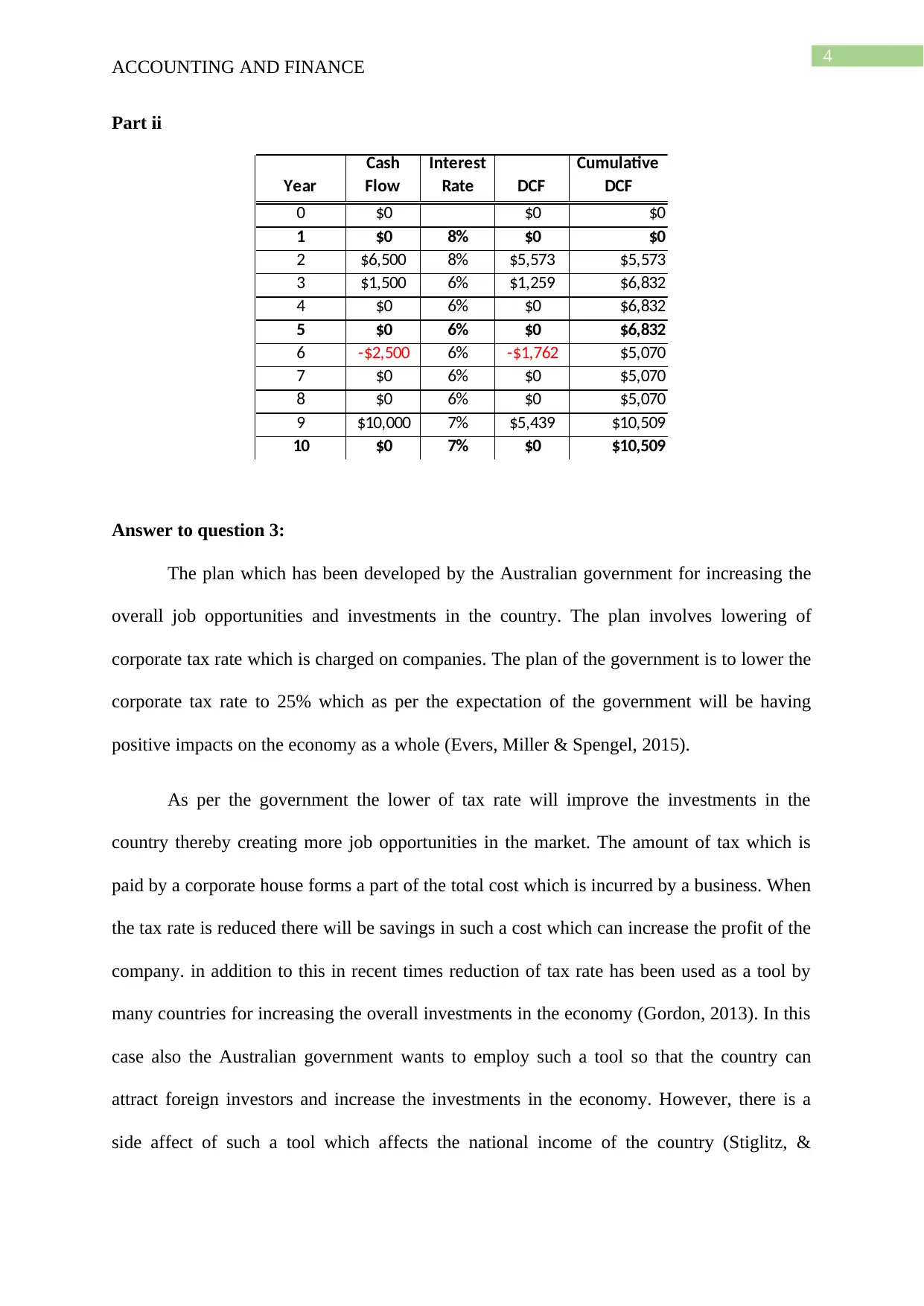
4
ACCOUNTING AND FINANCE
Part ii
Year
Cash
Flow
Interest
Rate DCF
Cumulative
DCF
0 $0 $0 $0
1 $0 8% $0 $0
2 $6,500 8% $5,573 $5,573
3 $1,500 6% $1,259 $6,832
4 $0 6% $0 $6,832
5 $0 6% $0 $6,832
6 -$2,500 6% -$1,762 $5,070
7 $0 6% $0 $5,070
8 $0 6% $0 $5,070
9 $10,000 7% $5,439 $10,509
10 $0 7% $0 $10,509
Answer to question 3:
The plan which has been developed by the Australian government for increasing the
overall job opportunities and investments in the country. The plan involves lowering of
corporate tax rate which is charged on companies. The plan of the government is to lower the
corporate tax rate to 25% which as per the expectation of the government will be having
positive impacts on the economy as a whole (Evers, Miller & Spengel, 2015).
As per the government the lower of tax rate will improve the investments in the
country thereby creating more job opportunities in the market. The amount of tax which is
paid by a corporate house forms a part of the total cost which is incurred by a business. When
the tax rate is reduced there will be savings in such a cost which can increase the profit of the
company. in addition to this in recent times reduction of tax rate has been used as a tool by
many countries for increasing the overall investments in the economy (Gordon, 2013). In this
case also the Australian government wants to employ such a tool so that the country can
attract foreign investors and increase the investments in the economy. However, there is a
side affect of such a tool which affects the national income of the country (Stiglitz, &
ACCOUNTING AND FINANCE
Part ii
Year
Cash
Flow
Interest
Rate DCF
Cumulative
DCF
0 $0 $0 $0
1 $0 8% $0 $0
2 $6,500 8% $5,573 $5,573
3 $1,500 6% $1,259 $6,832
4 $0 6% $0 $6,832
5 $0 6% $0 $6,832
6 -$2,500 6% -$1,762 $5,070
7 $0 6% $0 $5,070
8 $0 6% $0 $5,070
9 $10,000 7% $5,439 $10,509
10 $0 7% $0 $10,509
Answer to question 3:
The plan which has been developed by the Australian government for increasing the
overall job opportunities and investments in the country. The plan involves lowering of
corporate tax rate which is charged on companies. The plan of the government is to lower the
corporate tax rate to 25% which as per the expectation of the government will be having
positive impacts on the economy as a whole (Evers, Miller & Spengel, 2015).
As per the government the lower of tax rate will improve the investments in the
country thereby creating more job opportunities in the market. The amount of tax which is
paid by a corporate house forms a part of the total cost which is incurred by a business. When
the tax rate is reduced there will be savings in such a cost which can increase the profit of the
company. in addition to this in recent times reduction of tax rate has been used as a tool by
many countries for increasing the overall investments in the economy (Gordon, 2013). In this
case also the Australian government wants to employ such a tool so that the country can
attract foreign investors and increase the investments in the economy. However, there is a
side affect of such a tool which affects the national income of the country (Stiglitz, &
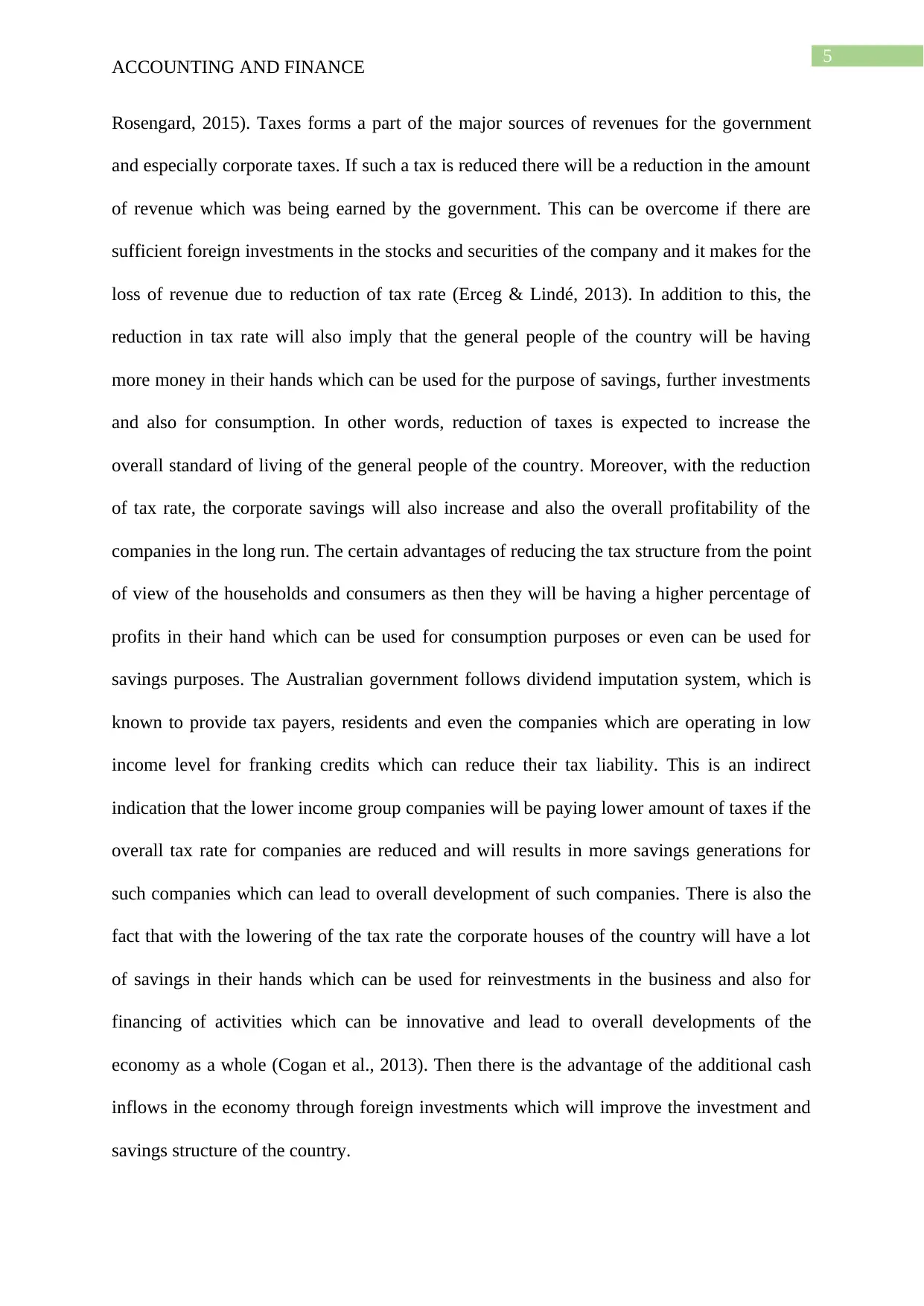
5
ACCOUNTING AND FINANCE
Rosengard, 2015). Taxes forms a part of the major sources of revenues for the government
and especially corporate taxes. If such a tax is reduced there will be a reduction in the amount
of revenue which was being earned by the government. This can be overcome if there are
sufficient foreign investments in the stocks and securities of the company and it makes for the
loss of revenue due to reduction of tax rate (Erceg & Lindé, 2013). In addition to this, the
reduction in tax rate will also imply that the general people of the country will be having
more money in their hands which can be used for the purpose of savings, further investments
and also for consumption. In other words, reduction of taxes is expected to increase the
overall standard of living of the general people of the country. Moreover, with the reduction
of tax rate, the corporate savings will also increase and also the overall profitability of the
companies in the long run. The certain advantages of reducing the tax structure from the point
of view of the households and consumers as then they will be having a higher percentage of
profits in their hand which can be used for consumption purposes or even can be used for
savings purposes. The Australian government follows dividend imputation system, which is
known to provide tax payers, residents and even the companies which are operating in low
income level for franking credits which can reduce their tax liability. This is an indirect
indication that the lower income group companies will be paying lower amount of taxes if the
overall tax rate for companies are reduced and will results in more savings generations for
such companies which can lead to overall development of such companies. There is also the
fact that with the lowering of the tax rate the corporate houses of the country will have a lot
of savings in their hands which can be used for reinvestments in the business and also for
financing of activities which can be innovative and lead to overall developments of the
economy as a whole (Cogan et al., 2013). Then there is the advantage of the additional cash
inflows in the economy through foreign investments which will improve the investment and
savings structure of the country.
ACCOUNTING AND FINANCE
Rosengard, 2015). Taxes forms a part of the major sources of revenues for the government
and especially corporate taxes. If such a tax is reduced there will be a reduction in the amount
of revenue which was being earned by the government. This can be overcome if there are
sufficient foreign investments in the stocks and securities of the company and it makes for the
loss of revenue due to reduction of tax rate (Erceg & Lindé, 2013). In addition to this, the
reduction in tax rate will also imply that the general people of the country will be having
more money in their hands which can be used for the purpose of savings, further investments
and also for consumption. In other words, reduction of taxes is expected to increase the
overall standard of living of the general people of the country. Moreover, with the reduction
of tax rate, the corporate savings will also increase and also the overall profitability of the
companies in the long run. The certain advantages of reducing the tax structure from the point
of view of the households and consumers as then they will be having a higher percentage of
profits in their hand which can be used for consumption purposes or even can be used for
savings purposes. The Australian government follows dividend imputation system, which is
known to provide tax payers, residents and even the companies which are operating in low
income level for franking credits which can reduce their tax liability. This is an indirect
indication that the lower income group companies will be paying lower amount of taxes if the
overall tax rate for companies are reduced and will results in more savings generations for
such companies which can lead to overall development of such companies. There is also the
fact that with the lowering of the tax rate the corporate houses of the country will have a lot
of savings in their hands which can be used for reinvestments in the business and also for
financing of activities which can be innovative and lead to overall developments of the
economy as a whole (Cogan et al., 2013). Then there is the advantage of the additional cash
inflows in the economy through foreign investments which will improve the investment and
savings structure of the country.
⊘ This is a preview!⊘
Do you want full access?
Subscribe today to unlock all pages.

Trusted by 1+ million students worldwide

6
ACCOUNTING AND FINANCE
The problems which are associated with the reduction of tax rate is that the market of
the country might look uncompetitive in nature and potential investors might not be willing to
invest their money in such an uncompetitive market. The lower of tax rate will thus result in
making the Australian market look unattractive and uncompetitive in nature amore moreover
from the perspective of the investors the market might be weak and unworthy for further
investments. The government should also look out for the negative impacts which are
associated with the lowering of taxes in the country.
Thus, from the above discussions it is clear that the economy will greatly benefit with
the reduction of tax rate for corporate houses even though there are some disadvantages but
the advantages of the policy is more. Thus, the government should lower the corporate tax
rate to increase the overall savings in the economy.
Answer to Question 4:
Part i:
2/1/2016
3/1/2016
4/1/2016
5/1/2016
6/1/2016
7/1/2016
8/1/2016
9/1/2016
10/1/2016
11/1/2016
12/1/2016
-10.00%
-5.00%
0.00%
5.00%
10.00%
15.00%
20.00%
25.00%
Monthly Returns
NAB BHP AORD
ACCOUNTING AND FINANCE
The problems which are associated with the reduction of tax rate is that the market of
the country might look uncompetitive in nature and potential investors might not be willing to
invest their money in such an uncompetitive market. The lower of tax rate will thus result in
making the Australian market look unattractive and uncompetitive in nature amore moreover
from the perspective of the investors the market might be weak and unworthy for further
investments. The government should also look out for the negative impacts which are
associated with the lowering of taxes in the country.
Thus, from the above discussions it is clear that the economy will greatly benefit with
the reduction of tax rate for corporate houses even though there are some disadvantages but
the advantages of the policy is more. Thus, the government should lower the corporate tax
rate to increase the overall savings in the economy.
Answer to Question 4:
Part i:
2/1/2016
3/1/2016
4/1/2016
5/1/2016
6/1/2016
7/1/2016
8/1/2016
9/1/2016
10/1/2016
11/1/2016
12/1/2016
-10.00%
-5.00%
0.00%
5.00%
10.00%
15.00%
20.00%
25.00%
Monthly Returns
NAB BHP AORD
Paraphrase This Document
Need a fresh take? Get an instant paraphrase of this document with our AI Paraphraser
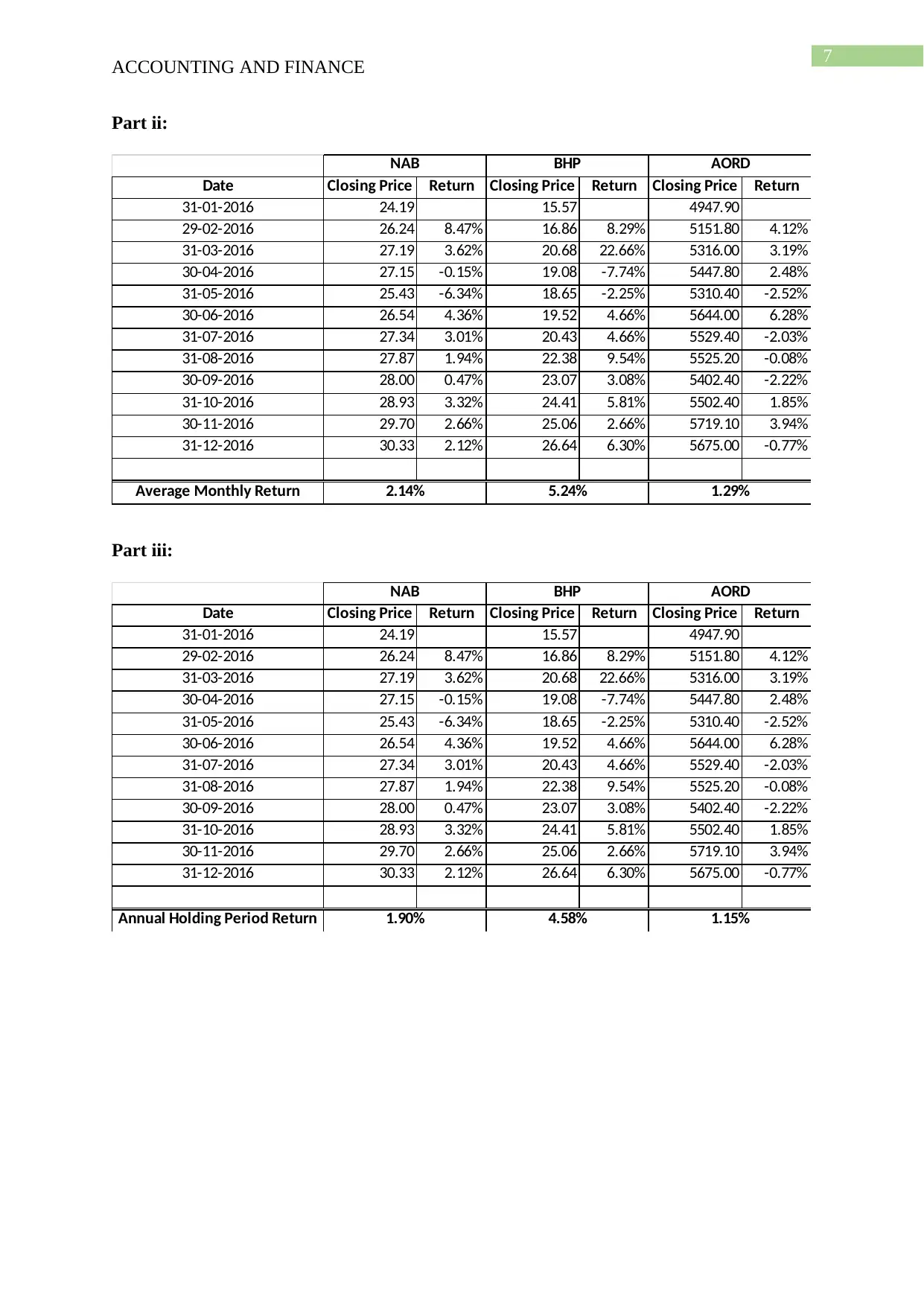
7
ACCOUNTING AND FINANCE
Part ii:
Date Closing Price Return Closing Price Return Closing Price Return
31-01-2016 24.19 15.57 4947.90
29-02-2016 26.24 8.47% 16.86 8.29% 5151.80 4.12%
31-03-2016 27.19 3.62% 20.68 22.66% 5316.00 3.19%
30-04-2016 27.15 -0.15% 19.08 -7.74% 5447.80 2.48%
31-05-2016 25.43 -6.34% 18.65 -2.25% 5310.40 -2.52%
30-06-2016 26.54 4.36% 19.52 4.66% 5644.00 6.28%
31-07-2016 27.34 3.01% 20.43 4.66% 5529.40 -2.03%
31-08-2016 27.87 1.94% 22.38 9.54% 5525.20 -0.08%
30-09-2016 28.00 0.47% 23.07 3.08% 5402.40 -2.22%
31-10-2016 28.93 3.32% 24.41 5.81% 5502.40 1.85%
30-11-2016 29.70 2.66% 25.06 2.66% 5719.10 3.94%
31-12-2016 30.33 2.12% 26.64 6.30% 5675.00 -0.77%
Average Monthly Return
NAB BHP AORD
2.14% 1.29%5.24%
Part iii:
Date Closing Price Return Closing Price Return Closing Price Return
31-01-2016 24.19 15.57 4947.90
29-02-2016 26.24 8.47% 16.86 8.29% 5151.80 4.12%
31-03-2016 27.19 3.62% 20.68 22.66% 5316.00 3.19%
30-04-2016 27.15 -0.15% 19.08 -7.74% 5447.80 2.48%
31-05-2016 25.43 -6.34% 18.65 -2.25% 5310.40 -2.52%
30-06-2016 26.54 4.36% 19.52 4.66% 5644.00 6.28%
31-07-2016 27.34 3.01% 20.43 4.66% 5529.40 -2.03%
31-08-2016 27.87 1.94% 22.38 9.54% 5525.20 -0.08%
30-09-2016 28.00 0.47% 23.07 3.08% 5402.40 -2.22%
31-10-2016 28.93 3.32% 24.41 5.81% 5502.40 1.85%
30-11-2016 29.70 2.66% 25.06 2.66% 5719.10 3.94%
31-12-2016 30.33 2.12% 26.64 6.30% 5675.00 -0.77%
Annual Holding Period Return
NAB BHP AORD
1.90% 1.15%4.58%
ACCOUNTING AND FINANCE
Part ii:
Date Closing Price Return Closing Price Return Closing Price Return
31-01-2016 24.19 15.57 4947.90
29-02-2016 26.24 8.47% 16.86 8.29% 5151.80 4.12%
31-03-2016 27.19 3.62% 20.68 22.66% 5316.00 3.19%
30-04-2016 27.15 -0.15% 19.08 -7.74% 5447.80 2.48%
31-05-2016 25.43 -6.34% 18.65 -2.25% 5310.40 -2.52%
30-06-2016 26.54 4.36% 19.52 4.66% 5644.00 6.28%
31-07-2016 27.34 3.01% 20.43 4.66% 5529.40 -2.03%
31-08-2016 27.87 1.94% 22.38 9.54% 5525.20 -0.08%
30-09-2016 28.00 0.47% 23.07 3.08% 5402.40 -2.22%
31-10-2016 28.93 3.32% 24.41 5.81% 5502.40 1.85%
30-11-2016 29.70 2.66% 25.06 2.66% 5719.10 3.94%
31-12-2016 30.33 2.12% 26.64 6.30% 5675.00 -0.77%
Average Monthly Return
NAB BHP AORD
2.14% 1.29%5.24%
Part iii:
Date Closing Price Return Closing Price Return Closing Price Return
31-01-2016 24.19 15.57 4947.90
29-02-2016 26.24 8.47% 16.86 8.29% 5151.80 4.12%
31-03-2016 27.19 3.62% 20.68 22.66% 5316.00 3.19%
30-04-2016 27.15 -0.15% 19.08 -7.74% 5447.80 2.48%
31-05-2016 25.43 -6.34% 18.65 -2.25% 5310.40 -2.52%
30-06-2016 26.54 4.36% 19.52 4.66% 5644.00 6.28%
31-07-2016 27.34 3.01% 20.43 4.66% 5529.40 -2.03%
31-08-2016 27.87 1.94% 22.38 9.54% 5525.20 -0.08%
30-09-2016 28.00 0.47% 23.07 3.08% 5402.40 -2.22%
31-10-2016 28.93 3.32% 24.41 5.81% 5502.40 1.85%
30-11-2016 29.70 2.66% 25.06 2.66% 5719.10 3.94%
31-12-2016 30.33 2.12% 26.64 6.30% 5675.00 -0.77%
Annual Holding Period Return
NAB BHP AORD
1.90% 1.15%4.58%
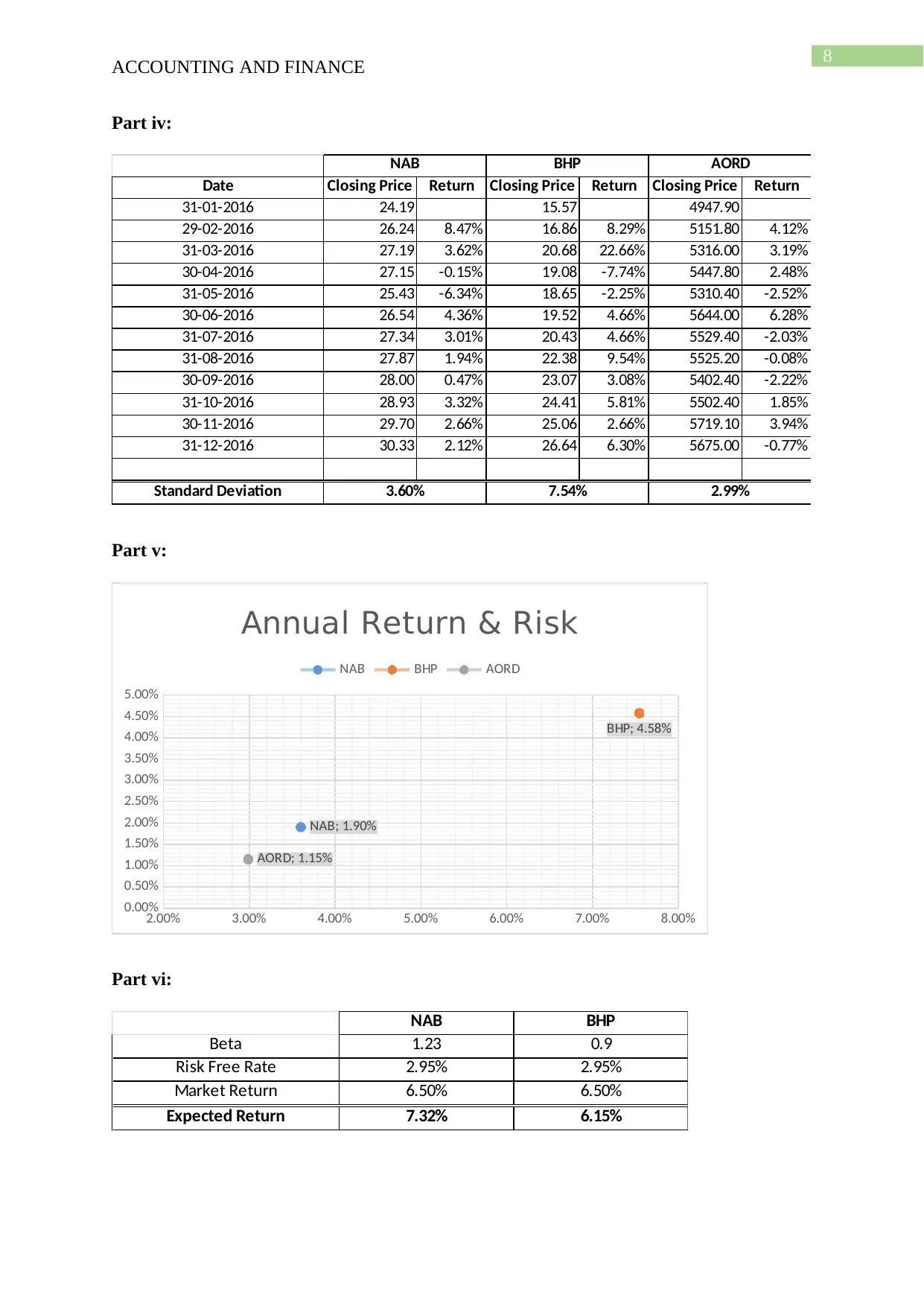
8
ACCOUNTING AND FINANCE
Part iv:
Date Closing Price Return Closing Price Return Closing Price Return
31-01-2016 24.19 15.57 4947.90
29-02-2016 26.24 8.47% 16.86 8.29% 5151.80 4.12%
31-03-2016 27.19 3.62% 20.68 22.66% 5316.00 3.19%
30-04-2016 27.15 -0.15% 19.08 -7.74% 5447.80 2.48%
31-05-2016 25.43 -6.34% 18.65 -2.25% 5310.40 -2.52%
30-06-2016 26.54 4.36% 19.52 4.66% 5644.00 6.28%
31-07-2016 27.34 3.01% 20.43 4.66% 5529.40 -2.03%
31-08-2016 27.87 1.94% 22.38 9.54% 5525.20 -0.08%
30-09-2016 28.00 0.47% 23.07 3.08% 5402.40 -2.22%
31-10-2016 28.93 3.32% 24.41 5.81% 5502.40 1.85%
30-11-2016 29.70 2.66% 25.06 2.66% 5719.10 3.94%
31-12-2016 30.33 2.12% 26.64 6.30% 5675.00 -0.77%
Standard Deviation
NAB BHP AORD
3.60% 2.99%7.54%
Part v:
2.00% 3.00% 4.00% 5.00% 6.00% 7.00% 8.00%
0.00%
0.50%
1.00%
1.50%
2.00%
2.50%
3.00%
3.50%
4.00%
4.50%
5.00%
AORD; 1.15%
BHP; 4.58%
NAB; 1.90%
Annual Return & Risk
NAB BHP AORD
Part vi:
Beta
Risk Free Rate
Market Return
Expected Return
NAB BHP
1.23
2.95%
6.50%
7.32%
0.9
2.95%
6.50%
6.15%
ACCOUNTING AND FINANCE
Part iv:
Date Closing Price Return Closing Price Return Closing Price Return
31-01-2016 24.19 15.57 4947.90
29-02-2016 26.24 8.47% 16.86 8.29% 5151.80 4.12%
31-03-2016 27.19 3.62% 20.68 22.66% 5316.00 3.19%
30-04-2016 27.15 -0.15% 19.08 -7.74% 5447.80 2.48%
31-05-2016 25.43 -6.34% 18.65 -2.25% 5310.40 -2.52%
30-06-2016 26.54 4.36% 19.52 4.66% 5644.00 6.28%
31-07-2016 27.34 3.01% 20.43 4.66% 5529.40 -2.03%
31-08-2016 27.87 1.94% 22.38 9.54% 5525.20 -0.08%
30-09-2016 28.00 0.47% 23.07 3.08% 5402.40 -2.22%
31-10-2016 28.93 3.32% 24.41 5.81% 5502.40 1.85%
30-11-2016 29.70 2.66% 25.06 2.66% 5719.10 3.94%
31-12-2016 30.33 2.12% 26.64 6.30% 5675.00 -0.77%
Standard Deviation
NAB BHP AORD
3.60% 2.99%7.54%
Part v:
2.00% 3.00% 4.00% 5.00% 6.00% 7.00% 8.00%
0.00%
0.50%
1.00%
1.50%
2.00%
2.50%
3.00%
3.50%
4.00%
4.50%
5.00%
AORD; 1.15%
BHP; 4.58%
NAB; 1.90%
Annual Return & Risk
NAB BHP AORD
Part vi:
Beta
Risk Free Rate
Market Return
Expected Return
NAB BHP
1.23
2.95%
6.50%
7.32%
0.9
2.95%
6.50%
6.15%
⊘ This is a preview!⊘
Do you want full access?
Subscribe today to unlock all pages.

Trusted by 1+ million students worldwide
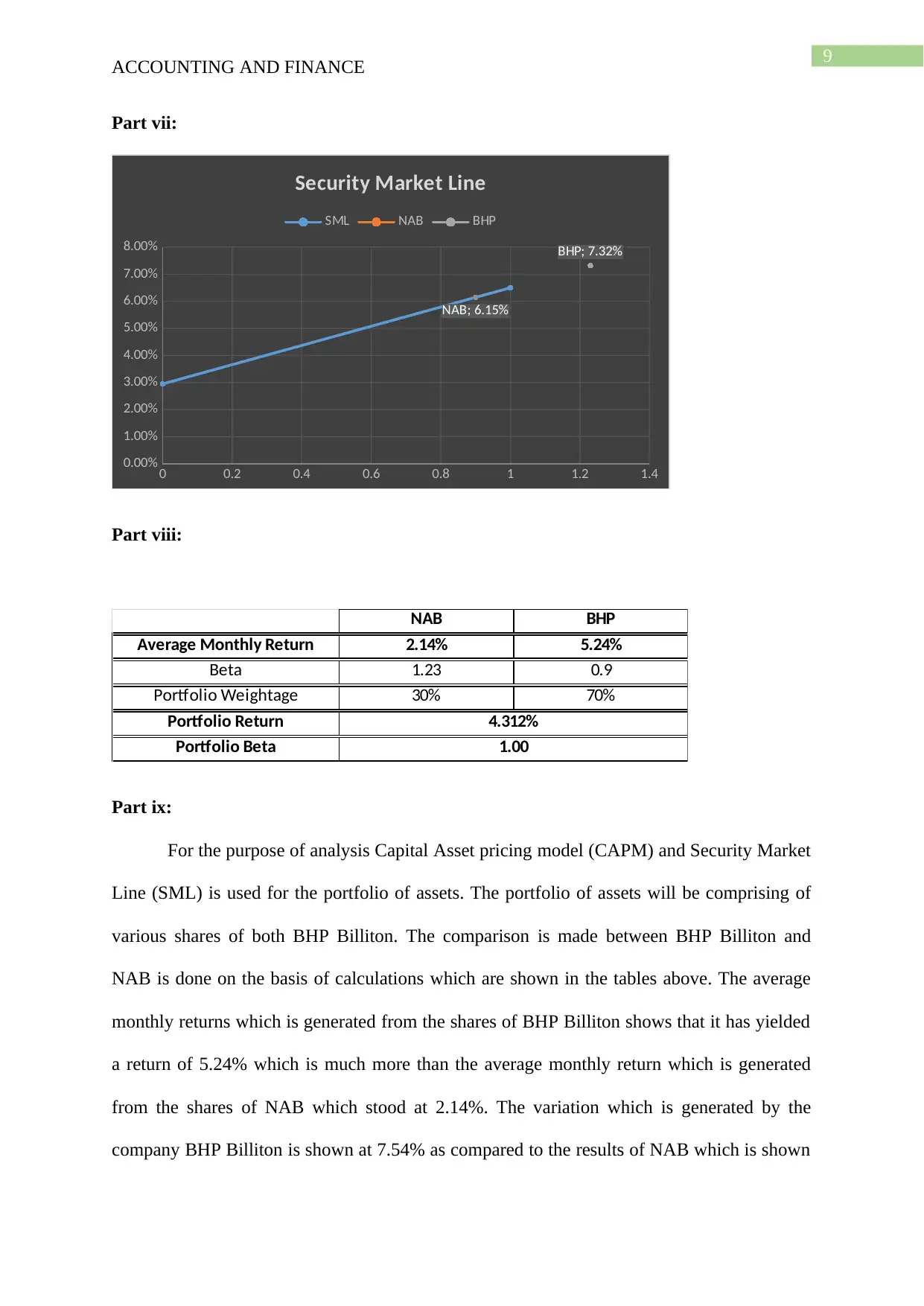
9
ACCOUNTING AND FINANCE
Part vii:
0 0.2 0.4 0.6 0.8 1 1.2 1.4
0.00%
1.00%
2.00%
3.00%
4.00%
5.00%
6.00%
7.00%
8.00% BHP; 7.32%
NAB; 6.15%
Security Market Line
SML NAB BHP
Part viii:
Average Monthly Return
Beta
Portfolio Weightage
Portfolio Return
Portfolio Beta
NAB BHP
4.312%
1.00
2.14%
1.23
70%30%
5.24%
0.9
Part ix:
For the purpose of analysis Capital Asset pricing model (CAPM) and Security Market
Line (SML) is used for the portfolio of assets. The portfolio of assets will be comprising of
various shares of both BHP Billiton. The comparison is made between BHP Billiton and
NAB is done on the basis of calculations which are shown in the tables above. The average
monthly returns which is generated from the shares of BHP Billiton shows that it has yielded
a return of 5.24% which is much more than the average monthly return which is generated
from the shares of NAB which stood at 2.14%. The variation which is generated by the
company BHP Billiton is shown at 7.54% as compared to the results of NAB which is shown
ACCOUNTING AND FINANCE
Part vii:
0 0.2 0.4 0.6 0.8 1 1.2 1.4
0.00%
1.00%
2.00%
3.00%
4.00%
5.00%
6.00%
7.00%
8.00% BHP; 7.32%
NAB; 6.15%
Security Market Line
SML NAB BHP
Part viii:
Average Monthly Return
Beta
Portfolio Weightage
Portfolio Return
Portfolio Beta
NAB BHP
4.312%
1.00
2.14%
1.23
70%30%
5.24%
0.9
Part ix:
For the purpose of analysis Capital Asset pricing model (CAPM) and Security Market
Line (SML) is used for the portfolio of assets. The portfolio of assets will be comprising of
various shares of both BHP Billiton. The comparison is made between BHP Billiton and
NAB is done on the basis of calculations which are shown in the tables above. The average
monthly returns which is generated from the shares of BHP Billiton shows that it has yielded
a return of 5.24% which is much more than the average monthly return which is generated
from the shares of NAB which stood at 2.14%. The variation which is generated by the
company BHP Billiton is shown at 7.54% as compared to the results of NAB which is shown
Paraphrase This Document
Need a fresh take? Get an instant paraphrase of this document with our AI Paraphraser
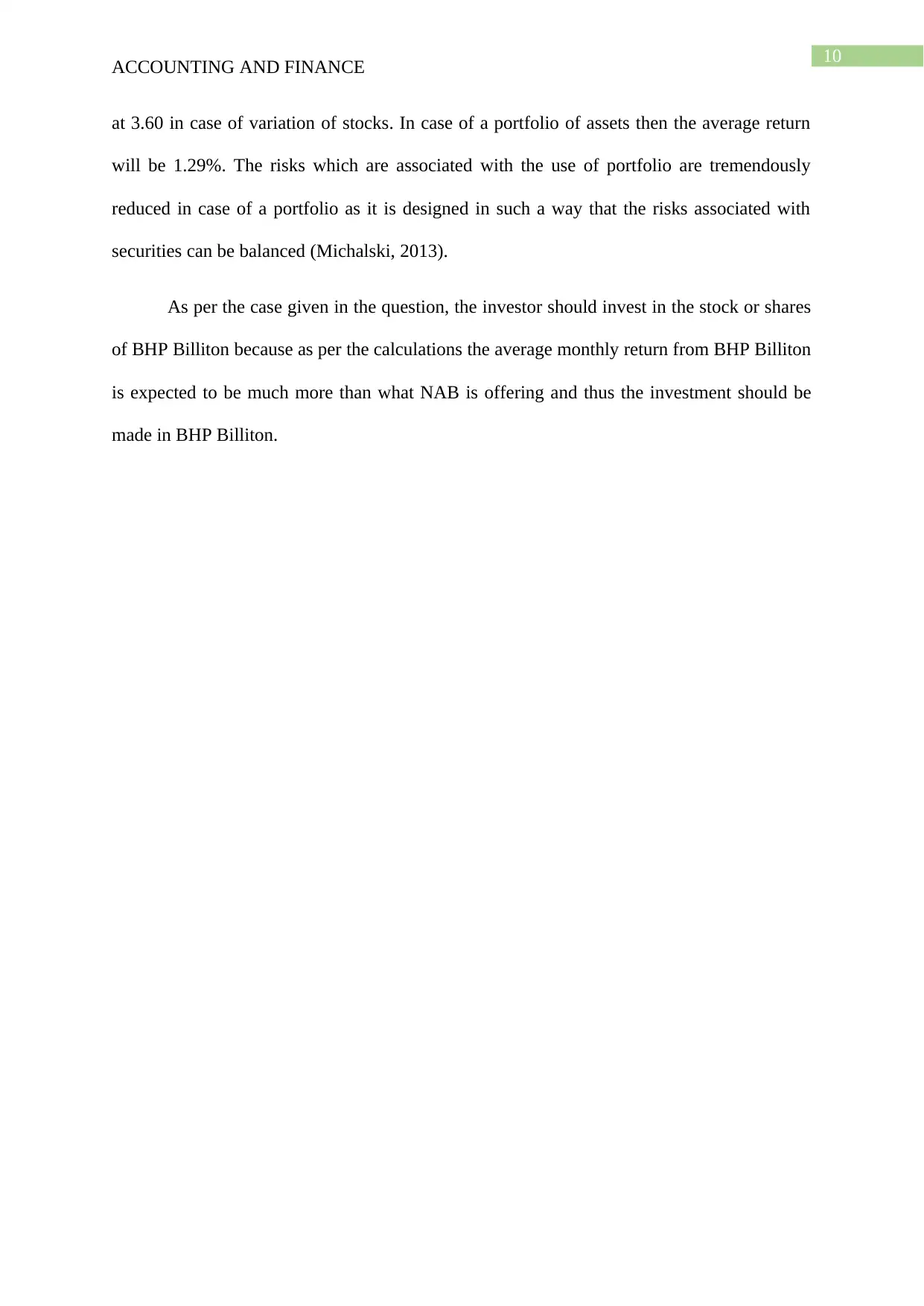
10
ACCOUNTING AND FINANCE
at 3.60 in case of variation of stocks. In case of a portfolio of assets then the average return
will be 1.29%. The risks which are associated with the use of portfolio are tremendously
reduced in case of a portfolio as it is designed in such a way that the risks associated with
securities can be balanced (Michalski, 2013).
As per the case given in the question, the investor should invest in the stock or shares
of BHP Billiton because as per the calculations the average monthly return from BHP Billiton
is expected to be much more than what NAB is offering and thus the investment should be
made in BHP Billiton.
ACCOUNTING AND FINANCE
at 3.60 in case of variation of stocks. In case of a portfolio of assets then the average return
will be 1.29%. The risks which are associated with the use of portfolio are tremendously
reduced in case of a portfolio as it is designed in such a way that the risks associated with
securities can be balanced (Michalski, 2013).
As per the case given in the question, the investor should invest in the stock or shares
of BHP Billiton because as per the calculations the average monthly return from BHP Billiton
is expected to be much more than what NAB is offering and thus the investment should be
made in BHP Billiton.
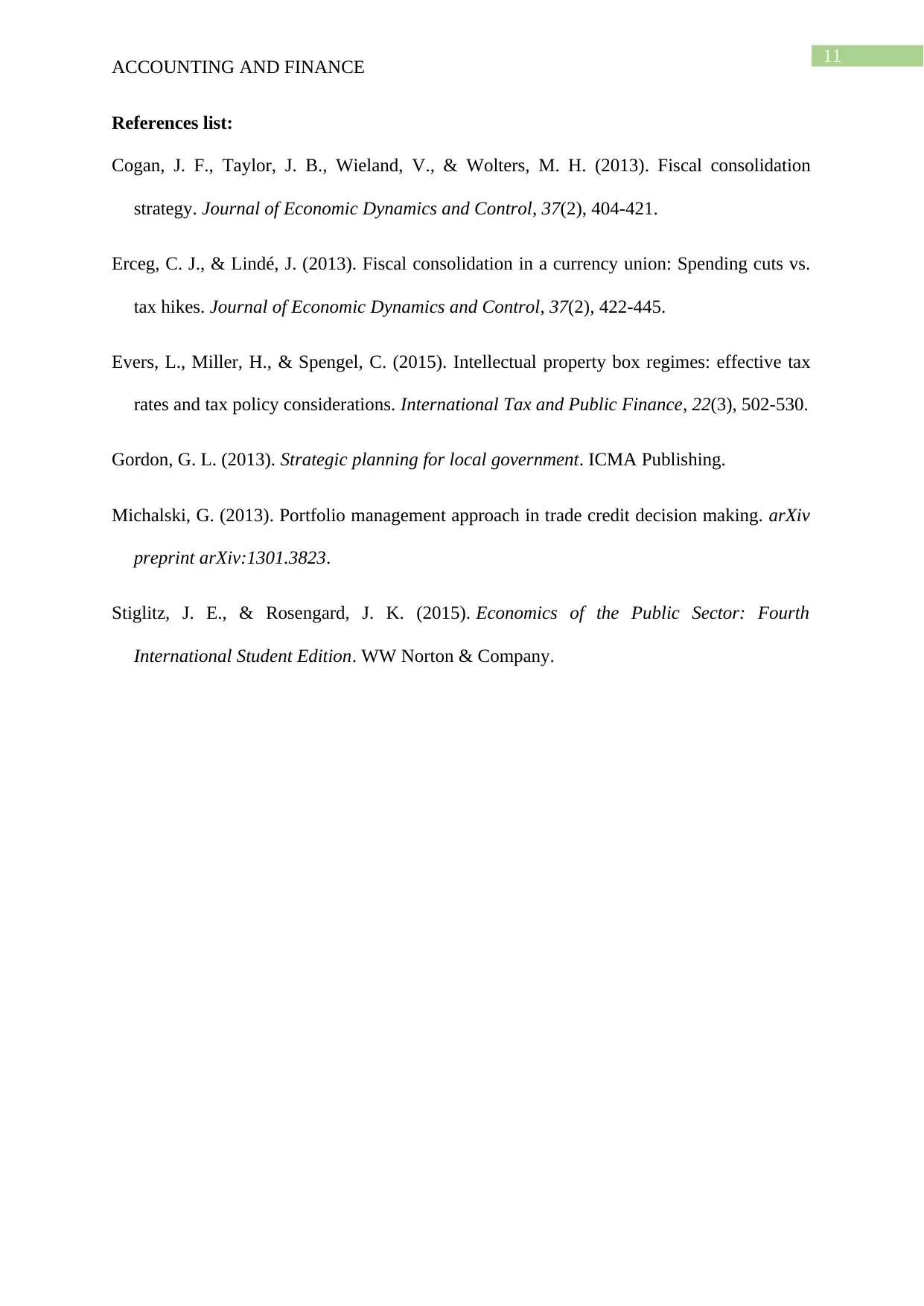
11
ACCOUNTING AND FINANCE
References list:
Cogan, J. F., Taylor, J. B., Wieland, V., & Wolters, M. H. (2013). Fiscal consolidation
strategy. Journal of Economic Dynamics and Control, 37(2), 404-421.
Erceg, C. J., & Lindé, J. (2013). Fiscal consolidation in a currency union: Spending cuts vs.
tax hikes. Journal of Economic Dynamics and Control, 37(2), 422-445.
Evers, L., Miller, H., & Spengel, C. (2015). Intellectual property box regimes: effective tax
rates and tax policy considerations. International Tax and Public Finance, 22(3), 502-530.
Gordon, G. L. (2013). Strategic planning for local government. ICMA Publishing.
Michalski, G. (2013). Portfolio management approach in trade credit decision making. arXiv
preprint arXiv:1301.3823.
Stiglitz, J. E., & Rosengard, J. K. (2015). Economics of the Public Sector: Fourth
International Student Edition. WW Norton & Company.
ACCOUNTING AND FINANCE
References list:
Cogan, J. F., Taylor, J. B., Wieland, V., & Wolters, M. H. (2013). Fiscal consolidation
strategy. Journal of Economic Dynamics and Control, 37(2), 404-421.
Erceg, C. J., & Lindé, J. (2013). Fiscal consolidation in a currency union: Spending cuts vs.
tax hikes. Journal of Economic Dynamics and Control, 37(2), 422-445.
Evers, L., Miller, H., & Spengel, C. (2015). Intellectual property box regimes: effective tax
rates and tax policy considerations. International Tax and Public Finance, 22(3), 502-530.
Gordon, G. L. (2013). Strategic planning for local government. ICMA Publishing.
Michalski, G. (2013). Portfolio management approach in trade credit decision making. arXiv
preprint arXiv:1301.3823.
Stiglitz, J. E., & Rosengard, J. K. (2015). Economics of the Public Sector: Fourth
International Student Edition. WW Norton & Company.
⊘ This is a preview!⊘
Do you want full access?
Subscribe today to unlock all pages.

Trusted by 1+ million students worldwide
1 out of 12
Related Documents
Your All-in-One AI-Powered Toolkit for Academic Success.
+13062052269
info@desklib.com
Available 24*7 on WhatsApp / Email
![[object Object]](/_next/static/media/star-bottom.7253800d.svg)
Unlock your academic potential
Copyright © 2020–2025 A2Z Services. All Rights Reserved. Developed and managed by ZUCOL.



